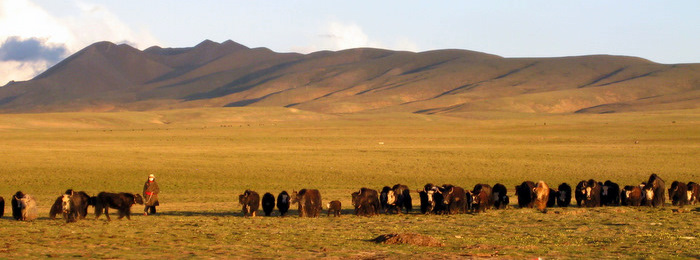Day 1: Xining – Shachung (Xiaqiong) Monastery – Rebkong (Chi: Tongren) [2480m]
Drive from Xining to Shachung Monastery, which is located on a mountaintop and has a great view of Yellow River in the opening valley. Afterwards, drive to Repkong via some muslim villages. Repkong is home to three large Tibetan Buddhist monasteries and is famous across Tibet for its artists. Along the way, catch beautiful views of the Yellow River.
Once we arrive Repkong, visit Rongwu Gonchen Monastery, which is located to the west of Rongwu Guchu River, in Tongren county, Huangnan Tibetan Prefecture. This monastery is the largest monastery in the region, originally founded as a Sakyapa Monastery in the 12th century, the Rongwu Monastery housed well over 2000 monks at the peak of it’s power. Now, it belongs to Gelupa order and has only about 400 monks.
Day 2: Rebkong – Gangya Grassland – Labrang (Xiahe) [2900m]
In the morning visit: visit Tibetan Artist villages(Wutun Si) to see monks painting Thangka, a traditional Buddhist painting. Afterwards, drive along the famous Gangya grassland to reach Sangchu town. The famous Labrang monastery is located at the western end of the town.
Day 3: Labrang and Dangra Tso Lake hike
Visit Labrang monastery and walk around the Tibetan style town. Labrang monastery is among the six leading Gelupa monasteries in the Tibetan world. It wields a great influence and attracts a large number of pilgrims from throughout the Amdo region. On the way to make a circumambulation around the monastery, you can stop by a Ngakpa Dratsang in the west end of the monastery. Afterwards, drive about 10km to visit Dangra Tso Lake, a local holy lake in the mountains surrounded by forests. Join locals to see how they do offerings, hanging prayer flags and fly Longta or Wind Horse in to the sky for wishing a great journey for their family and others. At last, a walk around the lake is a best way to call the day.
Day 4: Labrang – Sangko Grassaland – Lake Drangto Tso – Taktsang Lhamo (Chi: Langmusi) [3100m]
Drive along the Sangko Grassland which is 15km southwest of Labrang, where many Tibetan nomads live in the traditional way of life in the black yak hair tents. You can hire horse to on the Sangko grassland. Before reach Taktsang Lhamo, you will visit Lake Drangto Tso and Gahai bird sanctuary.
Day 5: Taktsang Lhamo [3100m]
Visit Lhamo monastery and Kirti Monastery. Nearby, take the opportunity to hike or ride horses along the forested hills.
Day 6: Taktsang Lhamo – Dzoge – Chuanzhusi monastery – Jiuzhaigou National Park [3000m]
You will travel to the nomad trading town of Zoige and Zungchu. Along the way you will see some of most beautiful grassland in Amdo and many Tibetans herding their yaks and sheep.
Note: Jiuzhaigou park is very busy in the summer season.
Day 7: Jiuzhaigou [3000m]
Visit Jiuzhaigou National Park, The waters of Jiuzhaigou Valley are widely known for their crystal-clearness, pure transparency and rich colorfulness. The mountains, waters, grass, woods, animals and birds here all are keeping their simple primitiveness without a single trace of artificiality. In the Y-shaped valley embraced by mountains are dispersed 114 terraced lakes and many shoal-rapids and waterfalls gradually flow from the heights to lower places in the green mountain valley, winding 50kms, with the blue sky, the white snow mountains and green forests mirrored in the clear lakes, forming a realm of integration of man and heaven against the primitive water-mills, stockaded villages and the forest of Buddhist streamers.
Day 8: Jiuzhaigou – Mounigou Scenic Park – View of Dujiangyan Irrigation system- Chengdu. [500m]
Mounigou Scenic Park is between Jiuzhaigou National Park and Chengdu, it belongs to west part of Huanglong Scenic park. its spectacular mountain scenery, cave clusters, large waterfalls and the surrounding culture combine to create an attractive landscape. Mounigou Valley mainly consists of Zhaga Waterfalls Scenic Spot and Er-daohai Scenic Spot. The major attractions are Zhaga Waterfalls, Mouni Forest, Bai-mu azalea, Erdaohai Lake, Flower Lake, Xiaobao Temple, Hou Temple, Emerald Hot Springs, Moon Lake, Swan Lake, etc.
When you reach the town of Dujiangyan, if it’s not fogy, you can see the Dujiangyan Irrigation System in distance. Our tour ends once you reach your hotel in Chengdu.
The tour can be extend by one day to explore city of Chengdu (Panda Breeding and Research Center, Old Street, Sichuan Hotpot.etc.)







